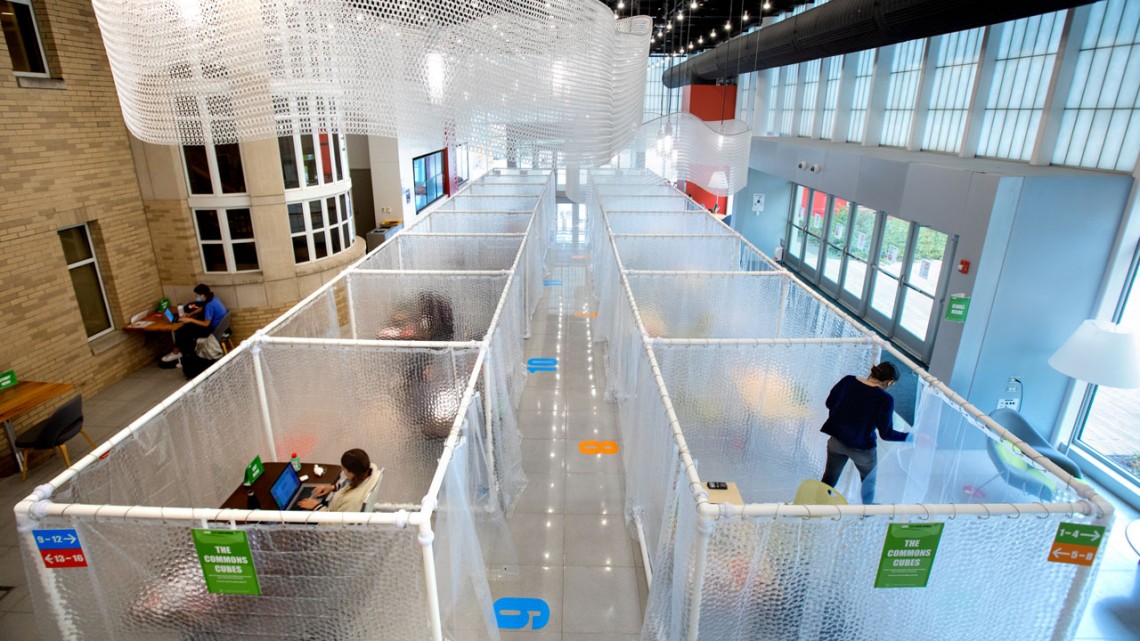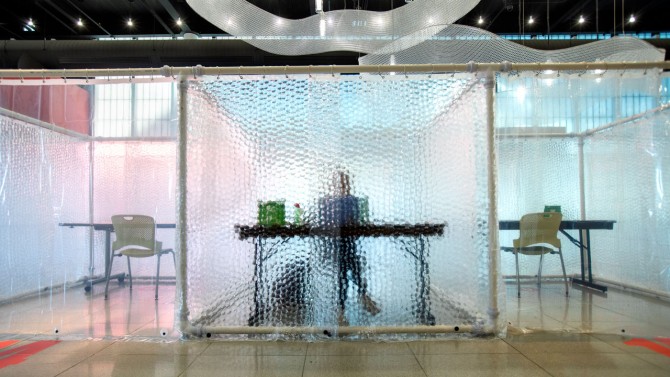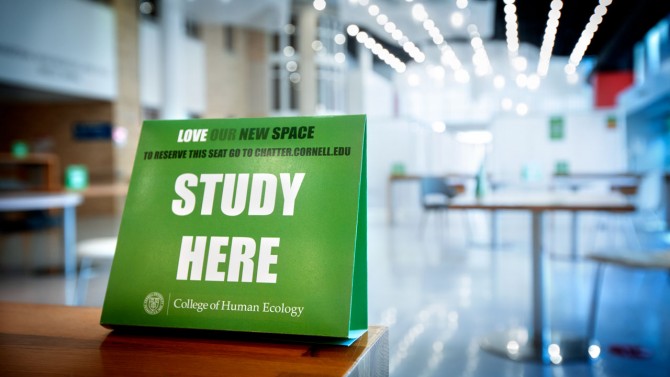
The college created 16 cubes in two offset rows in the Human Ecology Building Commons.
Human Ecology’s ‘commons cubes’ create safe study spots
By Melanie Lefkowitz
This fall, the College of Human Ecology planned to celebrate the completion of Martha Van Rensselaer Hall’s multi-year renovation. Instead, administrators and staff had to come up with creative ways to welcome students back – while reconfiguring the brand-new spaces for physical distancing.
“We didn’t want to lose that opportunity to connect with our student community and celebrate our new spaces, introduce them to aspects of the college that they hadn’t ever seen or experienced this way before,” said Kristine Mahoney, the college’s director of facilities. “When we were presented with the challenge of thinking about the student experience beyond the classroom, what kinds of spaces do they need, we said, ‘OK, we can do this. We can do two things at once. We can deliver them these other spaces and celebrate the new, renovated building at the same time.’”
What emerged was the “Love Our New Spaces” campaign, which uses welcoming signage to help students find safe study nooks, as well as the new “commons cubes”: 7-foot-square rooms within the 5,000-square-foot Human Ecology Building Commons, constructed by PVC pipe and separated by plastic sheeting.
The quirky cubes – all 16 of which were occupied on a recent rainy day – offer students a new way to safely spend time indoors on campus as the weather cools.
“As we started planning for a fall semester that was going to be different in so many ways, I was really interested in thinking not just about classrooms but the spaces students will need for time out of the classroom,” said Rachel Dunifon, the Rebecca Q. and James C. Morgan Dean of the College of Human Ecology, who this summer asked Mahoney to form a committee to explore ideas for creative student spaces.
“Students need places to eat, they need places to do their work, but they don’t necessarily want to be back in their dorms or their apartments all the time,” Dunifon said. “These cubes are so great because they’re beautiful and playful and interesting, but they’re also safe and healthy, and they give students a place to be on campus.”
Over the summer, Mahoney and colleagues brainstormed. Like plexiglass, they learned, shower curtains are considered an effective barrier. The patterned, translucent shower curtains and PVC pipe are a simple, inexpensive solution to create two offset rows of cubes.
“It was a really, really basic idea,” Mahoney said. “But it’s working.”
The committee also developed wayfinding signage: In addition to physically distanced green circles outdoors, they hung up green signs throughout the renovated building to show students around, with instructions guiding them to “Chill Here,” “Eat Here,” or “Study Here,” among other messages.
“I just felt that this needed to be a very positive and affirming message – education is why we’re all here,” said Rhonda Gilmore, senior lecturer and Weiss Teaching Fellow in the Department of Design and Environmental Analysis, who worked on the wayfinding plan. “The power of place needed to be not only celebrated, but offered to our students as another way to say that we care about them being here, that we want to provide this service to them and keep them safe.”
Joanna Luh ’21, a student intern who helped with the signage campaign, said the cubes provide students with some much-needed privacy – and optimism.
“Instead of expressing defeat in the situation that COVID-19 has placed the entire world in, they provide a safe and thoughtful way to accept the new normal and continue on,” Luh said.
In addition to the signage, Mahoney and her team redistributed furniture and reconfigured rooms throughout the building to make sure students could use them safely. In areas where students normally would cluster, for example, they spaced out the seating to encourage distancing, while making sure they could support their charging and Wi-Fi needs.
“Every single aspect of our building had to be rethought and reconfigured, and I’m really appreciative that Kristine and her team were able to take on this challenge of making things fun and creative and better for our students,” Dunifon said. “And I’m really grateful for our students, because they’ve had to be so patient and persistent, and they’re doing so much to keep all of us safe.”
The building renovation was funded using SUNY construction funds.
Media Contact
Get Cornell news delivered right to your inbox.
Subscribe


